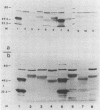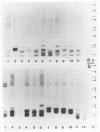Abstract
A simple discriminative typing method for Clostridium difficile has been developed. Sodium dodecyl sulfate-polyacrylamide gel electrophoresis of whole-cell proteins and restriction enzyme analysis are relatively simple techniques but are difficult to evaluate, especially the restriction enzyme analysis. Immunoblotting and restriction fragment length polymorphism typing facilitate simple discrimination of patterns.
Full text
PDF



Images in this article
Selected References
These references are in PubMed. This may not be the complete list of references from this article.
- Bartlett J. G. Antibiotic-associated pseudomembranous colitis. Rev Infect Dis. 1979 May-Jun;1(3):530–539. doi: 10.1093/clinids/1.3.530. [DOI] [PubMed] [Google Scholar]
- Bowman R. A., O'Neill G. L., Riley T. V. Non-radioactive restriction fragment length polymorphism (RFLP) typing of Clostridium difficile. FEMS Microbiol Lett. 1991 Apr 15;63(2-3):269–272. doi: 10.1016/0378-1097(91)90097-t. [DOI] [PubMed] [Google Scholar]
- Chen K., Neimark H., Rumore P., Steinman C. R. Broad range DNA probes for detecting and amplifying eubacterial nucleic acids. FEMS Microbiol Lett. 1989 Jan 1;48(1):19–24. doi: 10.1016/0378-1097(89)90139-0. [DOI] [PubMed] [Google Scholar]
- Delmée M., Laroche Y., Avesani V., Cornelis G. Comparison of serogrouping and polyacrylamide gel electrophoresis for typing Clostridium difficile. J Clin Microbiol. 1986 Dec;24(6):991–994. doi: 10.1128/jcm.24.6.991-994.1986. [DOI] [PMC free article] [PubMed] [Google Scholar]
- Johnson S., Clabots C. R., Linn F. V., Olson M. M., Peterson L. R., Gerding D. N. Nosocomial Clostridium difficile colonisation and disease. Lancet. 1990 Jul 14;336(8707):97–100. doi: 10.1016/0140-6736(90)91605-a. [DOI] [PubMed] [Google Scholar]
- McKay I., Coia J. E., Poxton I. R. Typing of Clostridium difficile causing diarrhoea in an orthopaedic ward. J Clin Pathol. 1989 May;42(5):511–515. doi: 10.1136/jcp.42.5.511. [DOI] [PMC free article] [PubMed] [Google Scholar]
- Tabaqchali S., Holland D., O'Farrell S., Silman R. Typing scheme for Clostridium difficile: its application in clinical and epidemiological studies. Lancet. 1984 Apr 28;1(8383):935–938. doi: 10.1016/s0140-6736(84)92392-4. [DOI] [PubMed] [Google Scholar]
- Thomas D. R., Bennett R. G., Laughon B. E., Greenough W. B., 3rd, Bartlett J. G. Postantibiotic colonization with Clostridium difficile in nursing home patients. J Am Geriatr Soc. 1990 Apr;38(4):415–420. doi: 10.1111/j.1532-5415.1990.tb03539.x. [DOI] [PubMed] [Google Scholar]




